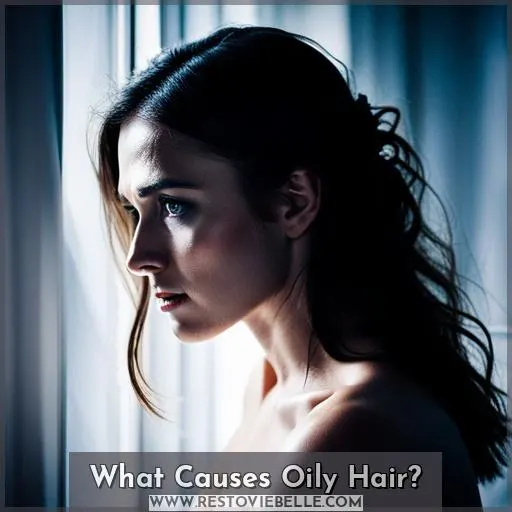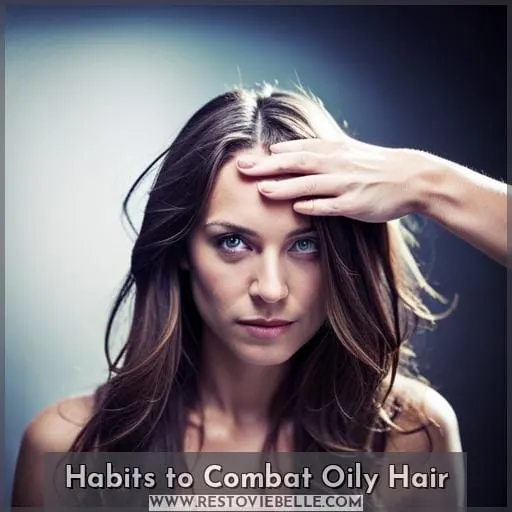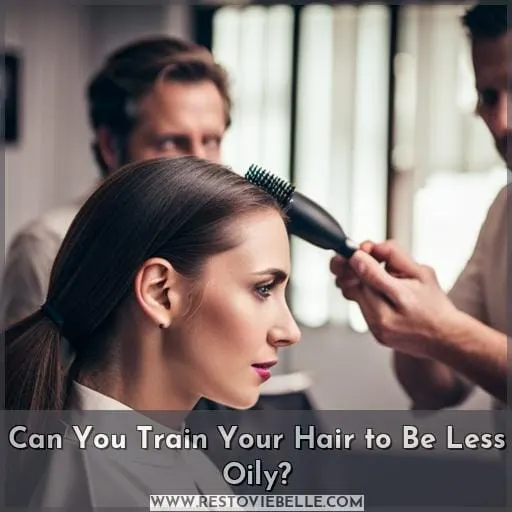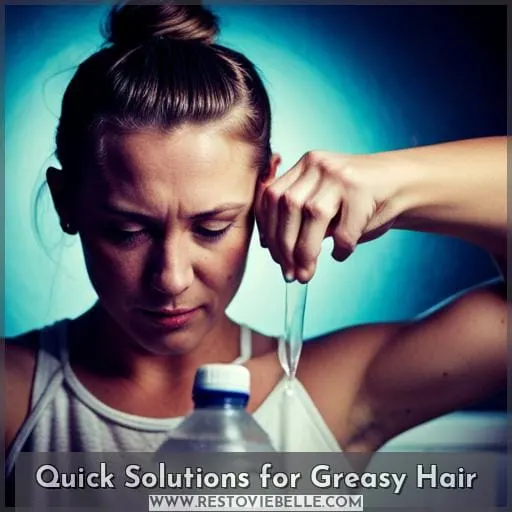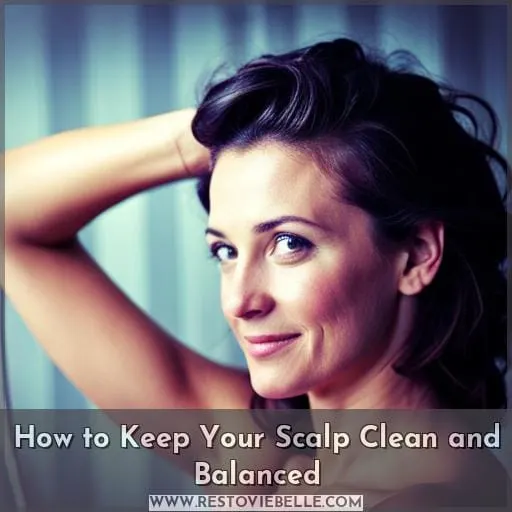This site is supported by our readers. We may earn a commission, at no cost to you, if you purchase through links.
 Feeling frustrated when you wake up to limp, lifeless locks weighed down by oil? You’re not alone. Excess scalp oil leaves hair looking dirty and feeling uncomfortable. But with a few simple habits you can gain control.
Feeling frustrated when you wake up to limp, lifeless locks weighed down by oil? You’re not alone. Excess scalp oil leaves hair looking dirty and feeling uncomfortable. But with a few simple habits you can gain control.
Learn expert tips to:
- Regulate overproductive glands
- Train hair to need less washing
- Quickly fix oil slick emergencies
Soon your hair will look fresh longer, with natural shine instead of greasy glare.
Table Of Contents
- Key Takeaways
- What Causes Oily Hair?
- Habits to Combat Oily Hair
- Can You Train Your Hair to Be Less Oily?
- Quick Solutions for Greasy Hair
- How to Keep Your Scalp Clean and Balanced
- Dietary Factors That Influence Oily Hair
- Scalp Toners for Oily Hair
- When Should You See a Dermatologist for Oily Hair?
- Frequently Asked Questions (FAQs)
- Conclusion
Key Takeaways
- Proper conditioning techniques
- Washing frequency
- Choosing the right brush
- Avoiding touching hai
What Causes Oily Hair?
Wondering why you have oily hair? There are several factors that can contribute to excess oil production on your scalp.
- Hormonal changes, such as those during puberty, pregnancy, and menopause, can affect the oil glands in your scalp and lead to greasy locks.
- Genetics also play a role in determining how much oil your scalp produces.
- Additionally, stress has been shown to impact the overall health of our skin and hair follicles, potentially leading to increased oiliness.
Hormone Changes Contribute
Hormone changes significantly contribute to the development of oily hair, affecting both men and women.
During puberty, pregnancy, and menopause, fluctuations in hormones like estrogen and testosterone trigger increased sebum production, leaving hair slick and greasy.
Changes in birth control methods or stress levels also impact hormone balance, disrupting the scalp and causing excess oil.
Monitoring lifestyle factors that affect hormones can help regulate greasy hair.
Genetics Play Key Role
Finding your hair’s oiliness being hereditary, with genetics predetermining your follicles’ sebum production. Genetics dominate the factors that contribute to oily hair, as genes passed down from parents can play a key role in determining the amount of oil produced by the scalp.
Understanding this genetic predisposition can help guide effective hair care strategies for managing slick locks and regulating oil production.
Stress Impacts Scalp Oil
When you’re stressed, your scalp produces more oil, leading to oily hair.
Stress triggers the oil glands in your scalp to produce an excessive amount of sebum, which is the natural oil that keeps your hair moisturized.
The excess oil can make your hair look greasy and contribute to conditions like seborrheic dermatitis and dandruff. Managing stress levels can help regulate oil production on the scalp and reduce oily hair concerns.
| Stress Impacts Scalp Oil |
|---|
| – Stimulates Oil Glands |
| – Increases Sebum Production |
| – Linked to Cortisol Hormone |
Habits to Combat Oily Hair
To combat oily hair, there are several important habits to develop.
First, make sure you’re properly conditioning your hair by applying conditioner only to the ends and thoroughly rinsing it out.
Second, try washing your hair less frequently as overwashing can strip the scalp of its natural oils and cause it to produce more oil in response.
Lastly, be mindful of touching your hair throughout the day as this can transfer oil from your hands onto your strands and make them appear greasier.
Proper Conditioning Techniques
To combat oily hair, it’s important to develop proper conditioning techniques that promote a balanced scalp and prevent excess oil production.
- Use leave-in conditioner for lightweight hydration, and avoid heavy products that can weigh down your hair.
- Deep condition weekly to nourish your locks without adding extra oil.
- Clarify the scalp with a sulfate-free shampoo and use dry shampoo as needed between washes.
Incorporate these habits into your routine for healthier, less greasy hair.
Washing Frequency
You’ll want to determine an optimal washing schedule for your hair type rather than over-washing, which can lead your scalp to overproduce oil.
Find the right frequency of shampooing to avoid both an oily scalp from inadequate cleansing and a dry, irritated scalp from overwashing.
An apple cider vinegar rinse can help restore balance.
Choosing the Right Brush
With a boar bristle brush in hand, you’re able to distribute oils from root through tips without aggravating sebum production.
Choose the right brush for your oily hair:
- Round brush for styling and adding volume
- Boar bristle brush for distributing natural oils
- Wide tooth comb for detangling wet hair
- Paddle brush for smoothing and straightening
Take care of your locks with the proper tools.
Avoiding Touching Hair
Your hair’s oil transfers from your hands, so don’t touch it.
Avoid using excessive hair products as they can weigh down your locks and contribute to oily hair.
Over-styling and heat styling can also stimulate excess oil production.
Additionally, avoid using heavy oils on your scalp and refrain from wearing hats for extended periods of time to allow proper airflow and prevent trapping oils on the scalp.
Can You Train Your Hair to Be Less Oily?
The notion’s out there that you can retrain your scalp’s oil production over time through strategic washing and styling adjustments. While it may not be possible to completely change your hair type, there are steps you can take to manage oily hair more effectively.
First and foremost, establish a consistent hair care routine tailored for oily scalp and hair types. This includes using gentle shampoos specifically designed for oily scalps, avoiding heavy conditioners on the roots of your hair, and thoroughly rinsing all products from your strands.
In addition to choosing the right products, training your hair also involves adjusting certain habits. For instance, avoid over-washing as it can strip away natural oils causing an increase in oil production by the scalp.
Instead aim to wash every 1-2 days or as needed based on how quickly oil builds up in your specific case.
Furthermore, embrace air-drying whenever possible instead of relying heavily on heat-styling tools that can exacerbate greasiness. When selecting hairstyles or applying any additional product such as dry shampoo or hairspray try keeping them away from direct contact with the roots where excess oil tends accumulate most noticeably.
Remember though; everyone’s experience with managing their individual levels of sebum is different so trial-and-error experimentation could help determine what works best for you personally.
Quick Solutions for Greasy Hair
If you’re dealing with greasy hair and need a quick solution, there are several options to try.
- Dry shampoo is a great option for absorbing excess oil and refreshing your hair between washes.
- Another effective remedy is an apple cider vinegar treatment, which can help remove product buildup and balance the pH of your scalp.
- Additionally, experimenting with different hairstyles that conceal oiliness can be a simple yet effective way to manage greasy hair on the go.
Dry Shampoo
To combat oily hair, one quick solution is dry shampoo. This handy spray absorbs excess oils, adds volume, and leaves hair refreshed between washes.
For best results, vigorously shake the can and spray dry shampoo directly onto roots from about 8 inches away, working in sections.
Popular brands like Dove and Batiste make dry shampoos catering to different hair types.
Apple Cider Vinegar Treatment
You’ll add 2 tablespoons apple cider vinegar to 8 ounces water for an effective hair rinse.
To use, after shampooing, pour the diluted vinegar over your hair.
Let it sit for 2-5 minutes before rinsing out.
Use this treatment once or twice a week.
The acetic acid in vinegar helps remove residue and balance pH.
Baking soda can be added to boost cleansing power without drying.
With some trial and error, you’ll find the ideal frequency and dilution for your hair.
Hairstyles to Conceal Oiliness
You can disguise oily hair by opting for hairstyles that conceal grease or add texture, like braids, buns, or ponytails.
- Updos like buns hide oily roots while adding volume
- Braided styles distract from slick hair with texture
- Half-up styles conceal oiliness at the crown
- Low ponytails hide greasy roots with a sleek look
- Messy buns texture oiliness into an intentional style
How to Keep Your Scalp Clean and Balanced
However, you can keep your scalp clean and balanced by using a clarifying shampoo once a week to remove product buildup without over-drying, massaging your scalp while conditioning to stimulate blood flow, and applying apple cider vinegar to restore pH balance.
Here are four tips for maintaining scalp health:
- Use a clarifying shampoo:
Incorporate the use of a clarifying shampoo into your hair care routine once a week. This will help remove any excess oil or product buildup on the scalp without stripping it of essential moisture.
- Massage your scalp while conditioning:
While applying conditioner, take some time to massage your scalp in circular motions with gentle pressure. This won’t only stimulate blood flow but also help distribute natural oils evenly throughout the hair.
- Exfoliate regularly:
Consider incorporating regular scalp exfoliation into your routine using products specifically designed for this purpose or by gently brushing with a soft brush made for scalps.
- Apply apple cider vinegar rinse:
After washing and conditioning, mix one part apple cider vinegar with two parts water. Pour this mixture onto wet hair, let sit for few minutes then rinse out completely. Apple cider vinegar helps restore pH balance which promotes healthy scalp.
By following these tips regularly, you can maintain proper oil production on the scalp as well as promote overall healthier looking locks.
Dietary Factors That Influence Oily Hair
When it comes to managing oily hair, dietary factors can play a role in regulating oil production.
Consuming excessive amounts of sugar and refined carbs can contribute to increased oiliness in the scalp and hair.
Additionally, dairy products have been found to influence sebum production, potentially exacerbating greasiness.
On the other hand, incorporating certain vitamins into your diet can help regulate oil production and promote healthier hair overall.
Sugar and Refined Carbs
Why do sugar and refined carbohydrates influence the production of excess scalp oil? Following a diet high in these foods prompts the body to produce more of certain hormones that stimulate the sebaceous glands, resulting in oilier hair for many people.
These dietary factors can lead to:
Inflammation
Acne
Increased sebum production
High blood sugar levels and insulin resistance also contribute to oily hair.
It’s important to make mindful choices about your diet in order to regulate oil production on your scalp.
| Dietary Factors That Influence Oily Hair |
|---|
| Inflammation |
| Acne |
| Sebum Production |
| Blood Sugar |
Dairy Products Contribution
To what extent do dairy products contribute to oily hair?
Consuming dairy can increase sebum production, leading to oilier hair for some people.
- Dairy increases certain hormones that stimulate excess oil
- Can worsen acne, suggesting it exacerbates oiliness
- Some research links high dairy intake to increased hair growth
So while evidence is mixed, limiting dairy may help control greasiness if you find it exacerbates oily hair.
Vitamins Regulate Oil Production
Boost your vitamin intake to regulate oil production and combat oily hair.
Consuming vitamins A, E, and C as well as zinc, biotin, and B-complex vitamins can help normalize oil secretion.
Make sure your diet includes vitamin-rich foods like eggs, nuts, citrus fruits, and leafy greens.
Getting enough vitamins may help regulate oil and prevent greasy locks.
Scalp Toners for Oily Hair
After reviewing how your diet impacts oil production, let’s look at how you can use scalp toners to help regulate and treat an oily scalp.
Scalp toners are specifically formulated products that can be applied directly to the scalp to balance oil production and control excess sebum.
One of the main benefits of using a scalp toner is that it helps remove impurities and buildup from the scalp, which can contribute to excessive oiliness. Additionally, these products often contain ingredients such as witch hazel or tea tree oil, known for their astringent properties that help tighten pores on the scalp.
When using a scalp toner for oily hair, it’s important to choose one suitable for your specific needs. There are different types available in the market ranging from liquid sprays to leave-in treatments or even DIY options made with natural ingredients.
To use a liquid spray type of tonic, simply apply it directly onto clean dry hair roots after washing or between washes when needed.
It is worth noting that some individuals may experience side effects such as dryness or irritation when using certain types of tonic due to sensitivities towards specific ingredients like alcohol-based solutions commonly found in many commercial brands’ formulations.
When Should You See a Dermatologist for Oily Hair?
If you’ve tried various methods to manage your oily hair but still find yourself struggling with excessive oil production, it may be time to seek professional help. While oily hair is a common issue, there are certain signs and symptoms that indicate the need for dermatological intervention.
Here are three situations where seeing a dermatologist for your oily hair is advisable:
- Persistent dandruff: If you have an itchy scalp accompanied by flaking and visible flakes on your clothing or shoulders, it could be a sign of seborrheic dermatitis. This condition can contribute to excess oil production and lead to greasy-looking hair.
- Scalp acne: Oily scalps can become breeding grounds for bacteria, leading to the development of scalp acne or pimples along the hairline or on top of the head.
- Hair thinning: Excessive oiliness can sometimes contribute to issues like clogged follicles and inflammation that may result in temporary shedding or even gradual thinning of the hair over time.
Frequently Asked Questions (FAQs)
Are there any dietary factors that can influence oily hair?
Dietary factors can play a role in oily hair.
Consuming a diet high in greasy, processed, and sugary foods may contribute to excess oil production on the scalp.
Incorporating more fruits, vegetables, and healthy fats can help balance oil levels.
Can you train your hair to be less oily?
Yes, you can train your hair to be less oily.
Gradually reduce the frequency of washing.
Use a clarifying shampoo occasionally.
Avoid excessive heat styling and product buildup.
Consistency and patience are key for achieving balanced oil production in your hair.
What are some quick solutions for greasy hair?
To quickly combat greasy hair, try using:
- A dry shampoo specifically designed for oily hair like Dove Dry Shampoo Volume Fullness
- Moroccanoil Clarifying Shampoo to remove residue buildup without stripping color or moisture.
How can I keep my scalp clean and balanced to prevent oily hair?
Use a gentle shampoo twice weekly.
Massage scalp to lift oil and debris without overdrying.
Rinse thoroughly.
Apply apple cider vinegar solution.
Let sit briefly before rinsing again to restore pH balance.
These habits remove buildup while maintaining skin’s moisture barrier.
When should I see a dermatologist for oily hair?
If your oily hair persists despite trying various remedies, it may be wise to consult a dermatologist.
They can evaluate your condition and provide personalized solutions that address the underlying causes of excessive oil production.
Conclusion
To beat greasy hair and regulate oil production, it’s important to understand the causes and develop good habits.
Hormone changes, genetics, and stress can all contribute to oily hair.
Proper conditioning techniques, washing frequency, and choosing the right brush can help combat excess oil.
Quick solutions like dry shampoo and apple cider vinegar treatments can also help in emergencies.
Additionally, paying attention to dietary factors and using scalp toners can keep your scalp clean and balanced.
If you’re struggling with oily hair, consider consulting a dermatologist for further guidance.

